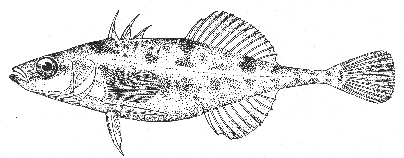Four-spined stickleback Apeltes quadracus (Mitchill) 1815
BLOODY STICKLEBACK
[Jordan and Evermann, 1896-1900, p. 752.]

Figure 171.—Four-spined stickleback (Apeltes quadracus), Woods Hole. From Jordan and Evermann. Drawing by A. H. Baldwin.
Description—
The four-spined stickleback has no bony plates in its scaleless skin, but it does have a bony ridge on each side of the abdomen, making it triangular in cross section, with flat belly and sharp back; this gives it an aspect very different from the other sticklebacks. It is fusiform in side view, tapering to the rather pointed nose and to the slim caudal peduncle. There are two to four free dorsal spines standing close one behind the other, inclining alternately to one side or the other, and another spine is attached to the dorsal fin by the fin membrane. The anal fin is similarly preceded by an attached spine, and each ventral fin is represented by a stouter curved spine, strongly saw-edged, followed by about two slender rays. The dorsal fin stands over the anal as in the nine-spined species, but both these fins are more rounded in outline, while the caudal fin is relatively longer and narrower than in any of our other sticklebacks.
Color—
Brownish olive or greenish brown above, with dark mottlings that alternate below the lateral line with the silvery white of the belly. The fin membrane of the ventrals is red. Males are much darker than females.
Size—
One and one-half to two and one-half inches long.
Habits—
This is a common little fish in the salt marshes, where it consorts with other sticklebacks and with mummichogs. Like the three-spined [page 312] stickleback it often runs up into freshwater, though it is primarily a salt and brackish water fish. And it is never found far in from the coast or out at sea.
In the Woods Hole region this stickleback spawns as early as May and as late as the last week of July, after which spent females are found; but the onset of spawning may be somewhat later in the cooler waters Of the Gulf. The male builds a nest of plant fragments which it brings in its mouth, cemented with mucous threads that he spins out of a pore near his vent; a small rudimentary affair, however, compared with that of the three-spined stickleback, described by Ryder[72] as less than 1 inch in diameter, conical, with an opening at the top. Finally, the male stickleback picks up the eggs that have been laid by the female and deposits them in the hollow at the top of the nest, guarding them, presumably, during incubation. The eggs are yellow, approximately 1.66 mm. in diameter; they sink like those of the other sticklebacks and stick together in clumps. Incubation occupies six days or thereabouts at laboratory temperature (about 70°). Newly hatched larvae are about 4.5 mm. long and similar in appearance to those of the three-spined species but more densely pigmented.[73]
General range—
This is an American fish, known along the coast from the southern side of the Gulf of St. Lawrence and Nova Scotia to Virginia; at home both in salt water and in brackish, and running up into fresh water.
Occurrence in the Gulf of Maine—
This stickleback is common all around the shores of the Gulf on the Nova Scotian side as well as the New England side. We have taken it at Yarmouth; Huntsman[74] records it from St. Mary Bay and along the New Brunswick shore well within the Bay of Fundy (Maine has usually been given as its northern limit), and there are many locality records for the coasts of Maine and Massachusetts. But it is so much more closely restricted to estuarine situations than is its three-spined relative (p. 310) that we have never taken it in our tow nets nor do we find a single record of it in the open sea. On the south shore of New England it is a year-round resident. Probably this is equally true in the Gulf, where it may be expected to gather in the bottoms of the deeper creeks in winter, as it is known to do in Chesapeake Bay. It resembles the three-spined stickleback in its feeding habits so far as known (copepods and other small crustaceans being its chief diet) and in its general mode of life.